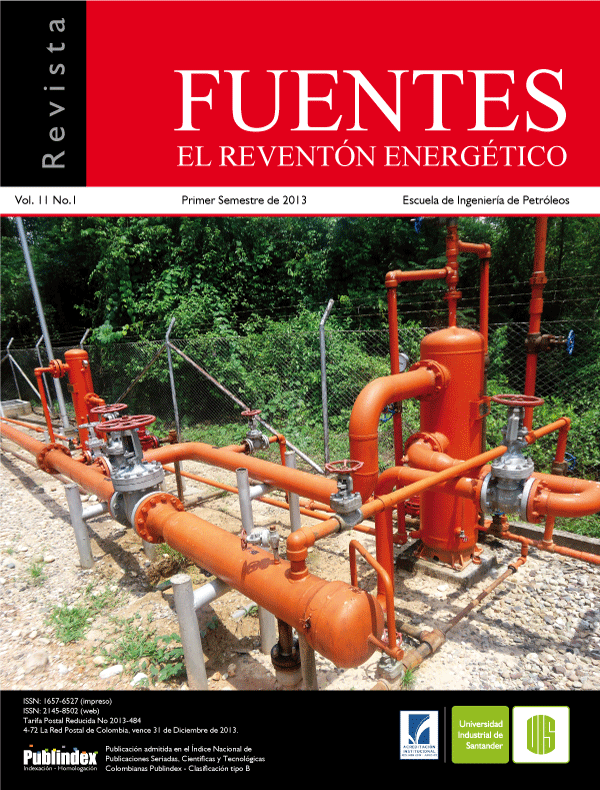Calculation of the thermal efficiency of a steamflooding process in stratified reservoirs
Published 2013-11-06
Keywords
- Thermal efficiency,
- Sand-shale ratio,
- Steamflooding,
- Stratified reservoir,
- Heavy oil
- Numerical simulation ...More
How to Cite
Abstract
Heavy oil reservoirs show a predominant importance because they are associated with the largest reserves in the world. For this reason, it has resulted in the development of enhanced recovery techniques such as steamflooding, to facilitate the production of heavy oil. However, the common practice has evidenced the presence of shale within producing formations, which negatively affect the efficiency of thermal recovery processes.
This study was conducted from the construction of simulation conceptual models, with different spacing between wells and different sand-shale ratio, with the purpose of analyze how much of the energy supplied to the producing formation
through the steam is being exploited by the same, and what portion has been trapped by shales. Results show that the thermal efficiency of the process is affected for the presence of shale formations, mainly when these are of great thickness, which has reflected in the index productivity low. Moreover, it was observed that decreasing the spacing between wells, allowed best recovery factors due to that steamflooding is more efficient. The final results of this investigation led to development of correlations that allow the calculation of the thermal efficiency of a steamflooding process in heavy oil reservoirs with shales intercalated. These correlations may be applied in subsequent studies as long as characteristics of models going to be evaluated are similar to in the models in this study. With this work it is sought to make a contribution to the industry in the area of enhanced oil recovery for producing high viscosity oil.
Downloads
References
2. aLvaRaDO D, BanZER C.: “Recuperación térmica de Petróleo”. Capítulo 2. Propiedades térmicas de Rocas y Fluidos. Universidad del Zulia. Maracaibo, Noviembre 1998.
3. aLI FaROUQ. “Practical Heavy Oil Recovery”. Chapter 7. Steamflooding. 2006. P 7-1.
4. GOnZaLO G.L.: “Recuperación Mejorada de Hidrocarburos: Inyección Cíclica y Continua de vapor”. Capítulo 1. noviembre de 1989.
5. BURSELL, C.G. anD PIttMan, G.M.: “Performance of Steam Displacement the Kern River
6. LOnDOnI a. y aStIZ B.L.: “Oil Well Spacing a technical and Economic analysis”. SPE 8111.Conference paper in 5th World Petroleum Congress, May 30 - June 5, 1959, new York, USa.
7. BELtRan JESUS EnRIQUE: “análisis e interpretación de yacimientos sometidos a inyección continua de vapor mediante analogías” tesis de grado. Universidad Industrial de Santander, Bucaramanga. 2005.
9. MatEUS, YESSICa.: “Evaluación técnica y Económica del Uso de vapor para acelerar el Factor de Recobro en Yacimientos Estratificados de Crudo Pesado”. tesis Universidad Industrial de Santander. Proyecto de grado. Universidad Industrial de Santander, UIS. Bucaramanga 2011.
10. GREEn, DOn W. y WILLHItE, G. Paul. Enhanced Oil recovery. Society of petroleum Engineers. Texas, 1998.
11. PRatS MICHaEL Et aL.: “the Heat Efficiency of thermal Recovery Processes”. Journal of Petroleum technology. 21(3). SPE 2211-Pa.1969.
12. OSORIO G.: “Introducción a la simulación numérica de yacimientos”. Capítulo 1.
13. PaRIS M.: “Inyección de agua y Gas en Yacimientos Petrolíferos”. Capitulo cuatro. Desplazamientos de fluidos inmiscibles. Segunda edición.
14. CURtIS CaRL.: “Yacimientos de Petróleo Pesado”. Revista Oil Fiel Review 15 (4): 32-55, 2003.
15. ESCOBaR F. y SEPULvEDa J.: “Simulación de yacimientos: Principios, Conceptos y Construcción de Mallas”. Unidad 1.
16. BOBERG C. tHOMaS. “thermal methods of oil recovery” pag 13917. PRatS MICHaEL. :” the heat efficiency of thermal recovery processes pag 329
18. BUtLER. M, ROGER.: “thermal Recovery of Oil and Bitumen”. Prentice Hall. alberta, Canada. p.180.
19. HOnG, K.C.: Steamflood Reservoir Management. PennWell Books, tulsa, Oklahoma. 1994. P. 279.
